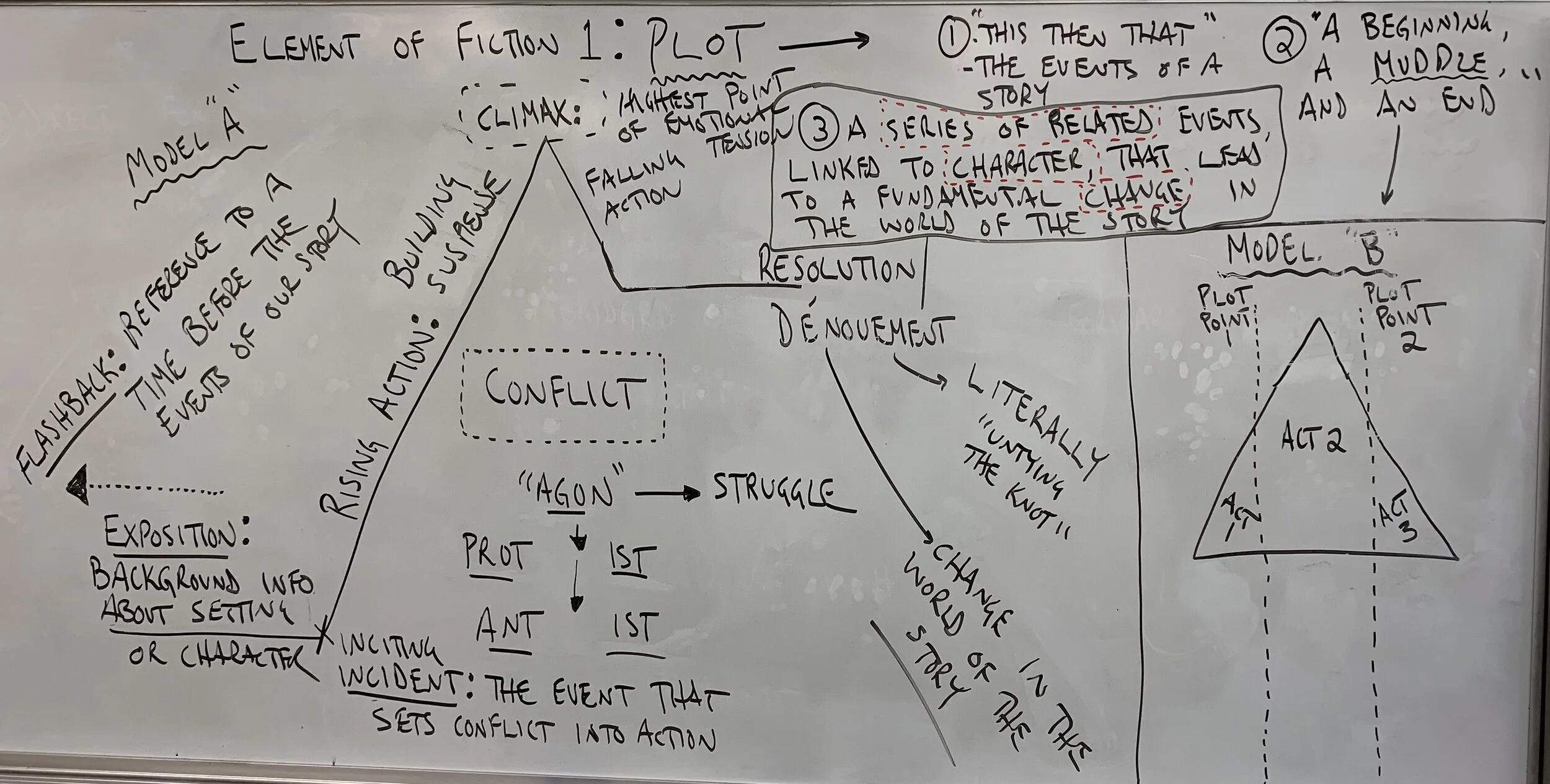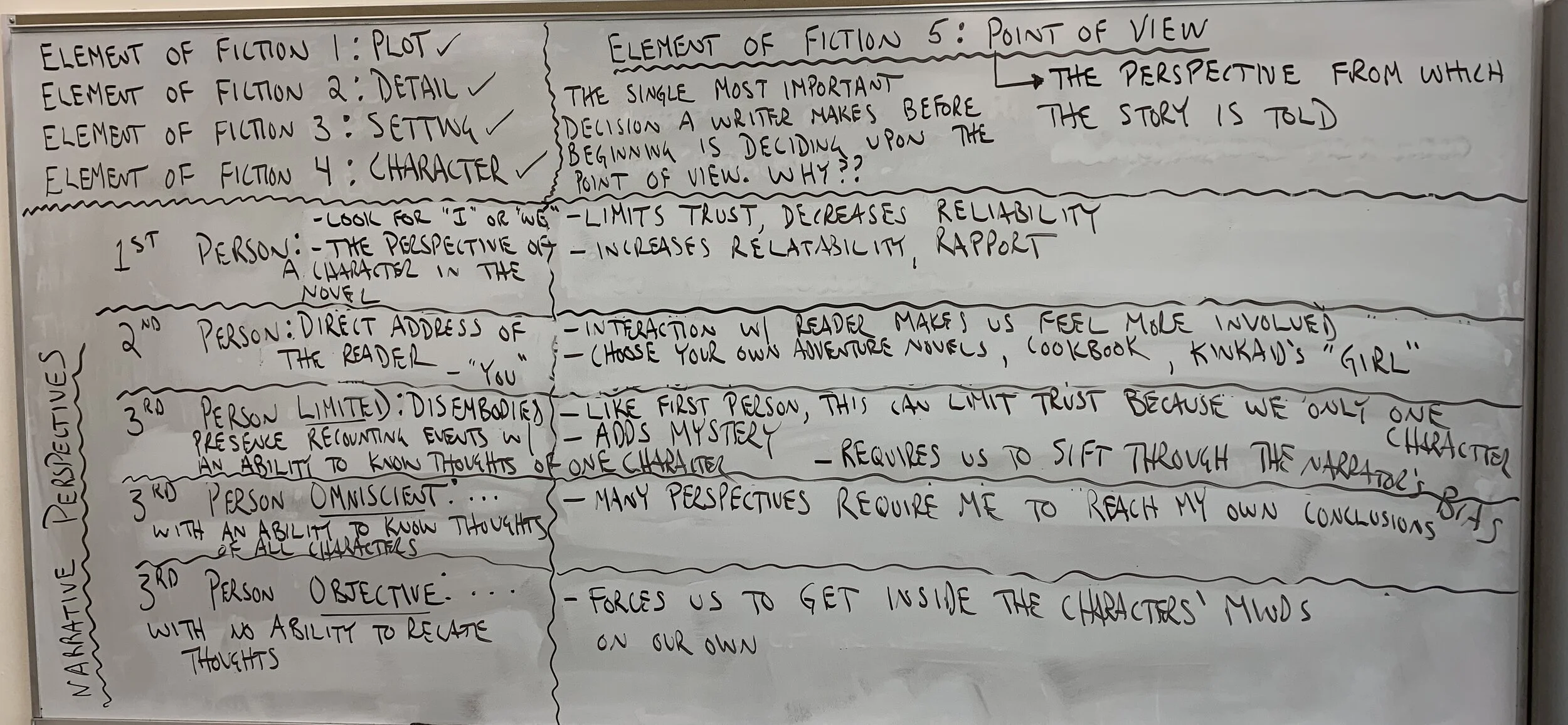<— Previous Assignments Back to this week’s assignments —>
Unit three: the great american short story
What is the role of the individual in society? | What is the relationship between a story’s plot and the characters in the story? | What makes a really great detail in a story?
How do writers use setting to develop themes in their stories? | What is the difference between a story’s subject and its theme? | What takes a story into the realm of great literature?
TO DO: Over the weekend, you’re going to read two Kate Chopin short stories, one of which you may have read before as a freshman. Regardless, read it again as a refresher. The first story is found in your short story anthology; it’s called “A Pair of Silk Stockings”. The second, “The Story of an Hour”, I have provided as a handout.
CYCLE 6, CLASS 3 october 18, 19
Today you’re going to break up into pairs and work through a comparison/contrast of “A Pair of Silk Stockings” and “The Story of an Hour”.
TO DO: Read William Faulkner’s short story “A Rose for Emily”, which I’ve provided for you as a handout.
CYCLE 6, CLASS 4 october 19, 20
Today we’ll have a roundtable discussion of Faulkner’s “A Rose for Emily”.
TO DO: Read Flannery O’Connor’s short story “A Good Man is Hard to Find”. Reserve enough time to read the story, which is a bit longer. I’ll provide the story as a handout.
CYCLE 6, CLASS 5 october 21, 22
Today we’ll have a group quiz before another roundtable discussion, this time about O’Connor’s extraordinary short story.
TO DO: Read Kurt Vonnegut’s short story “Harrison Bergeron”, which I have provided as a handout.
GREEN/WHITE october 25, 26
The Road Vocabulary Quiz
“Harrison Bergeron” Discussion
Review for short fiction test
TO DO: Study for your short fiction test.
————————————————————————————————————
CYCLE 5, CLASS 3 october 4, 5
(1) Terms for more critically studying fiction—You’ll be responsible for knowing the following: plot, character, setting, detail, point of view, theme, protagonist, antagonist, exposition, climax, conflict, resolution, flashback, foil, flat/round character, motif, irony, tone, symbol, mood, suspense, omniscience, unreliable narrator
(2) Today, after I hand out and explain the doc on our terms for studying fiction, we’ll turn to a discussion on “The Yellow Wallpaper,” our first short story in the unit. The elements of fiction we’ll discuss most today are detail, setting, and point of view.
TO DO:
(1) Continue thinking about your essay on The Crucible. Write and bring to our next class a draft of a thesis statement. It can be, at this point, rough or ready. In the second half of our next class, we’ll once again go through what a complete thesis statement looks like; you’ll have time to revise the one you brought.
CYCLE 5, CLASS 4 october 5, 6
(1) Today you may or may not but most definitely will have a quiz on “The Yellow Wallpaper”. We’ll follow it up by putting a bow on the story.
(2) Let’s move to thesis statements at this point. How did you do with your draft? I want to up a few up on the board and help you revise.
(3) Once you have a thesis, what’s the next step? Ask yourself, “What does my thesis demand I do structurally to fully prove the idea?” Break up your thesis into topics and write your topic sentences.
TO DO:
(1) Define your topics for your essay. Write your topic sentences. Now your essay has its structure!
(2) Read Washington Irving’s 1819 story “Rip Van Winkle”. I’ll provide you with a hard copy of the story. THINK: How does Irving characterize the newly born country of America? What do the hotel, the image of George Washington, the behavior of the crowd, and Rip’s attitude toward these changes show us about the new nation?
CYCLE 5, CLASS 5 october 7, 8
(1) Today we’ll discuss Washington Irving’s short story “Rip Van Winkle.” What do we learn about this newly formed country of ours?
(2) Openers and Closers: What do I expect from your opening and closing paragraphs?
TO DO:
(1) Continue writing your essay on The Crucible. By this point you should have a thesis, topic sentences, and passages you plan to closely read in your body paragraphs. Now it’s time to begin assembly. Write for at least one hour over the long weekend. Think critically and aim to arrive at more incisive conclusions about the characters and ideas in the play than you did in your body paragraphs.
(2) Read Herman Melville’s “Bartleby,” which can be found in Great American Short Stories on pages 18-48. It’s a longer story, so you may want to break it up into 2 sittings. THINK: (1) The narrator is a character in his own right; in fact, this story tells as much about him as it does about Bartleby. What do we learn about him in the first few paragraphs? What does his language (including the use of terms like "imprimis" and constructions like "not insensible" and "hath") tell us about him? Are there any contradictions involved in being an "unambitious lawyer" who admires John Jacob Astor? (2) Before introducing Bartleby, the narrator introduces us to three other workers: Turkey, Nippers, and Ginger Nut. What are they like? What is the purpose of introducing them first? How does the narrator's response to them (and his forbearance with their faults) shape the reader's reactions to what follows? (3) Do you sympathize more with Bartleby or the narrator? What would you have done with Bartleby?
CYCLE 6, CLASS 1 october 12, 14
(1) “Bartleby, The Scrivener” discussion using Fr. Johnson’s model for student-led discussion:
(1) What do you like or not like about this story? (2) Regardless of what you liked or didn’t like, what should we discuss as a class? (3) Do you consider this to be “art/literature”? Why or why not?
TO DO:
(1) Read Poe, “The Tell-Tale Heart,” found in Great American Short Stories on pages 13-17.
(2) Continue working on your essay, which is due next class.
CYCLE 6, CLASS 2 october 14, 15
Today, after we discuss Poe’s “The Tell-Tale Heart”, you’ll have some more time to draft your essay, which is due during our next class.
TO DO: Over the weekend, you’re going to read two Kate Chopin short stories, one of which you may have read before as a freshman. Regardless, read it again as a refresher. The first story is found in your short story anthology; it’s called “A Pair of Silk Stockings”. The second, “The Story of an Hour”, I have provided as a handout.
what's due?
October 18, 19 - The Crucible Essay #2
October 21, 22 - “AGMIHTF” Reading Quiz
October 25, 26 - The Road Vocabulary Quiz 1
October 28, 29 - Short Fiction Test
Reading and Discussion Schedule
CURRENT TEXT TO HAVE DAILY
notes
upcoming units
What does it mean to be an American?
Puritanism: Then and Now
The Great American Short Story
Novel Study: Cormac McCarthy’s The Road
———
American War Literature
Navigating the Media
The Problem with the American Dream
Independent Novel Study / Research Assignment
enjoying literature
Literature's emotional lessons
Authors on the power of literature
How reading makes us more human
STUDYING LITERATURE
"6 reading habits from Harvard"
Achebe, "The Truth of Fiction"
Questions for analyzing novels













